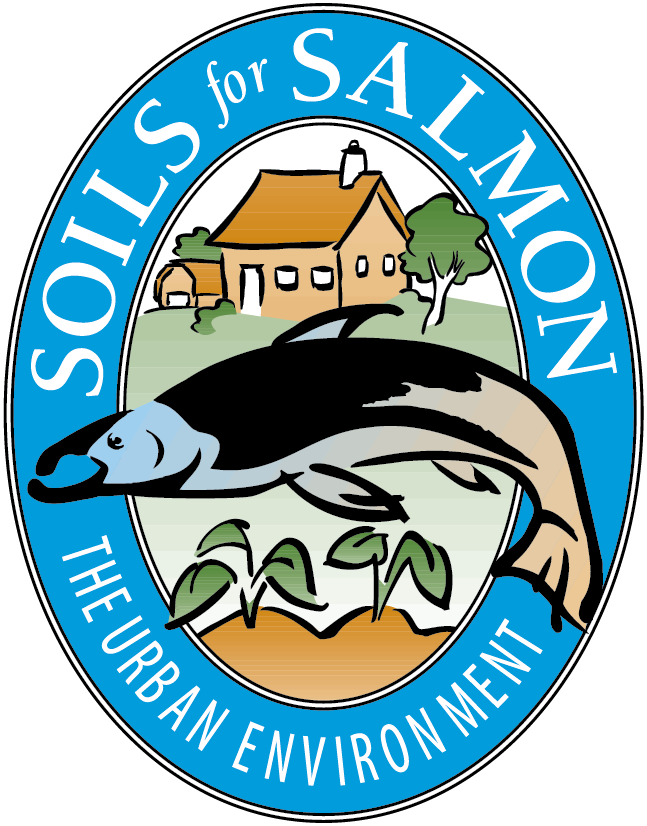Examples: Successful Projects
Successful Construction Managers are Using Soil Protection and Compost Amendment, compost in erosion control, and other Low Impact Development methods around the Northwest. Here are some examples – do you know more?
At Redmond Ridge, Quadrant Homes fences and protects existing forest as an amenity and stormwater filter. Then they grade to 12 inches below finish grade, stockpiling the topsoil. Next step is to place rock pads for roads and driveways.
Once foundations are in and houses are framed and sided, 14 inches of compost-amended reused soil is placed (to allow for settling to 12-inch finish grade). The compost blend prevents erosion, so work can proceed year-round.
On many sites (here in a Snohomish home remodel) it is more cost effective to till compost into the existing soil. Tilling 2-3 inches of compost into any soil – sand, clay or till – makes planting easier and grows a healthier landscape.
At Shamrock Heights, Cam West Development combines a traditional feel with innovative stormwater methods. Reuse of high-quality site soil, plus mulching, support a vibrant landscape.
At Issaquah Highlands, Port Blakely Communities uses compost blankets for erosion control and cost-effective vegetation establishment on slopes.
Port Blakely also uses compost-amended soils in park and home landscapes, for a high-end, quality product that sells, and attracts future customers too!
Selling Healthy Soil: Pro’s and homebuyers agree on the value:
Jim Berger, Construction Manager for Port Blakely Communities at Issaquah Highlands, says "These soil practices work better than anything we’ve tried – plants survive the first winter, and slopes don’t need to be fixed later. It’s a key part of our sustainable building program. Using compost blankets on slopes and compost soil amendments throughout the project not only prevents erosion right away – it gives us great vegetation establishment, even on difficult sites."
Jeff Cox, ASLA, of Triad Associates confirms, "Placing amended soils or stockpiling topsoils has front-end costs, but there can be long-term savings and benefits, from healthier plant material, better growing medium, and water quality improvements."
Greg Rabourn, co-host of Yard Talk TV show adds, "Plants aren’t cheap! Replacing them costs time and money. Spending a little on the soil saves money on water, plant replacement, and landscape chemicals. And a healthy, vibrant landscape is better for sale value."
Site planning consultant Howard Stenn notes, "Preserving areas of undisturbed vegetation saves on stormwater detention, landscaping, and development costs. Compost soil amendment makes for quicker planting and faster establishment. There’s no doubt these practices help sell a project."
Jim Thompson, a Shamrock Heights homeowner says, "It adds value to the home now while we live in it, and for the future when we sell. I think it adds great value to the community too."
Customers value a healthy, easy-care landscape, and that starts with healthy soil.
See More Case Studies
The Washington Stormwater Center’s Low Impact Development site documents and links to a variety of private and public projects around Puget Sound. They combine soil best practices with other innovative, attractive, and cost-effective on-site methods for stormwater treatment, detention, and infiltration.
Seattle’s Green Stormwater Infrastructure, Natural Drainage Systems, and RainWise websites show before and after photos, specifications, and descriptions of projects from small swale and "raingarden" retrofits to the 130 acre High Point development. All them use compost-amended soil to improve infiltration, clean runoff, and reduce the size or need for stormwater ponds and other detention structures.
Sustainable Landscaping Professionals shows case studies, guides, videos, and other training resources.
Sustainable Sites is the first nationally recognized rating system for sustainable site and landscape development, similar to the popular LEED green building standards. It includes soil requirements similar to Washington's, and links to case studies around the U.S.
Do you know of a project in the Northwest that belongs on this page? Send a short description, with your contact information, to Contact Us








